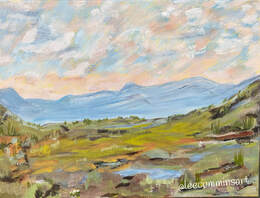 Just this weekend, I was gifted a weekend to myself. Hubby headed off to a blokes weekend in the country and I had the house to myself. As our little fluffy mate passed away over three months ago, there was no one relying on me or waiting for me. I was as free as a bird to do as I pleased. The monthly paint-out had been postponed due to inclement weather. This had been my only commitment over the weekend. After heading out for some extra art supplies I headed back to my studio with the heater blasting and started on a project I had not had time to do for months. The panels I had purchased had sat there on my shelving teasing me every time I went into the art shed. They would look at me and I at them, wishing I had the time to take them off the shelf, unwrap them and then cover them with creamy delicious acrylic paint. I started slowly on my idea using paper and working on my idea for the eight panels. Suddenly two hours had slipped by as I worked on a small 20cm x 20cm piece. I was happy with the outcome. Finally, the next day I set up in the garden room with panels, paint, water, brushes, palettes and paper towels, I was ready. I could now start on my project giving it my full attention. Throughout the process, I mixed an array of colours, used a variety of mark-making tools and skimmed books for the right words to jump out at me for the collage. It was exhilarating, to say the least. I didn't stop for a coffee or a break, I was so focused and in my zone. After many hours, I was finished, it was time to sit back and let them dry so they could be varnished. The gift of a weekend to enjoy creating was invigorating, peaceful and filled with what I love to do. I think you need one of these weekends once and a while. How would you spend the gift of a weekend to yourself? Leave your comment below. Featured artwork: Unscaled Peaks and Uncharted Waters
0 Comments
 A few years ago, I did a course on using a limited palette. I found it to be a stretch initially using just a few colours and black and white. So what is a limited palette? Imagine you're baking biscuits, but you only have a few ingredients in your pantry. A limited palette in art is like that, it's when you choose to work with only a small set of colours instead of having every colour available, just like having only a few ingredients for your biscuits. So, instead of using every colour in your art supplies kit, you might pick just three or four main colours, like red, blue, yellow, and maybe white. I also like to have black or Payne's Grey. With these colours, you can mix and blend them together to create all sorts of new and exciting colours. Working with a limited palette is a fun challenge. It helps you focus on learning how colours work together and how to mix them just right to get the shades you want. Plus, it can make your artwork look really harmonious and cohesive because all the colours are related to each other, just like all the ingredients in your biscuits work together to make them taste great! One of the main reasons I love to work with a limited palette, it makes me stretch myself with blending colours to get just what I need and want for a particular piece. The photo of a work in progress in this post is using a limited palette of cobalt blue, Payne's grey, cadmium yellow and burnt sienna with white for adjusting tones. Mixing colour with a limited palette is one of my favourite ways to paint. If you are just starting out, you can start with a few colours and mix your colours without buying every tube on the shelf! So, think of a limited palette as your artistic recipe. You might not have every colour in the world, but with a little mixing and experimenting, you can create something really special! You can find some of my favourite tools here If you have favourite colours you use in a limited palette, why not share them in the comments below. |
AuthorLee Cummins is a mixed media artist, workshop and art class facilitator. Archives
July 2024
Categories
All
|

 RSS Feed
RSS Feed
